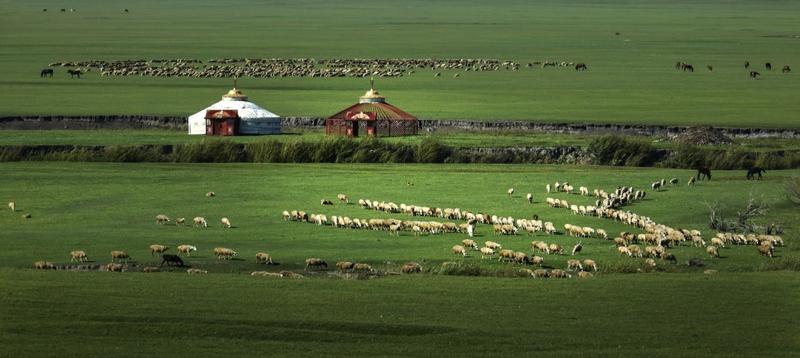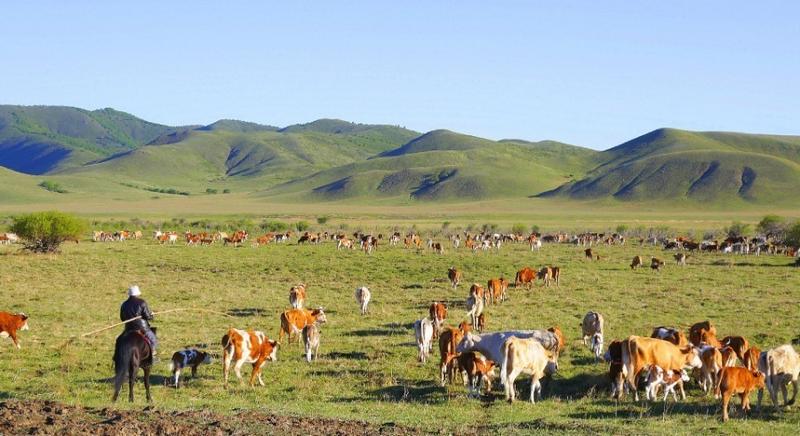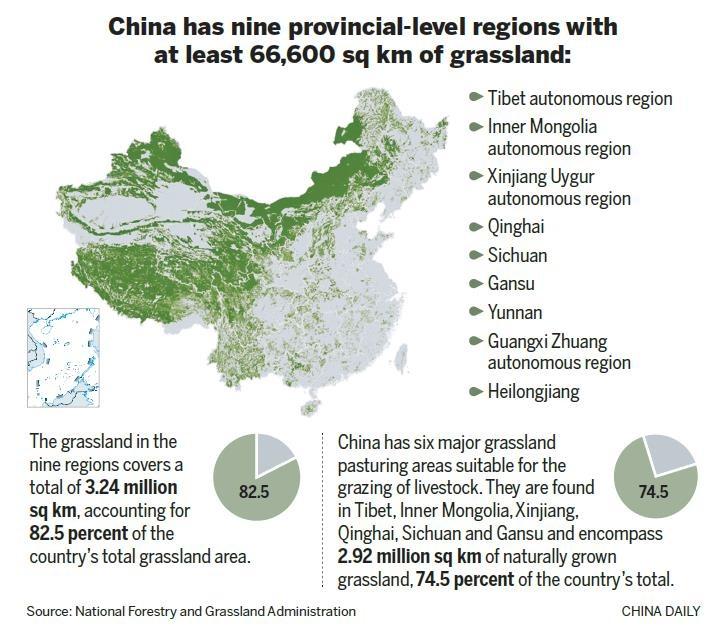 In this undated photo, sheep and horses graze on pastureland in Chen Barag Banner, Inner Mongolia autonomous region. (PHOTO PROVIDED TO CHINA DAILY)
In this undated photo, sheep and horses graze on pastureland in Chen Barag Banner, Inner Mongolia autonomous region. (PHOTO PROVIDED TO CHINA DAILY)
Ting Baatar, a herdsman from the Inner Mongolia autonomous region, had no reservations when it came to suggesting changes to traditional grazing practices that have helped restore and protect the grassland ecosystem.
Raising sheep used to be the life blood of tens of thousands of herdsmen in Saruultuya Gastaa, in Inner Mongolia’s Xiliin Gol League, but the animals took a tremendous toll on the environment.
The solution Ting, 65, suggested was switching to raising beef cattle — an industry that now has bright prospects.
To prevent grassland desertification, China’s central government has prohibited grazing in some areas and placed limits on the practice in others
Xi said the region’s environment should be protected firmly and strictly, without any exceptions. He also called for stronger protection efforts in line with the principle of working out measures that suit local conditions. During the second session of the 13th National People’s Congress, the country’s top legislature, in March 2019, President Xi Jinping, who is also general secretary of the Communist Party of China Central Committee and chairman of the Central Military Commission, participated in a discussion held by deputies from Inner Mongolia.
“We should explore new ways for high-quality development, which prioritize ecological protection and the green economy,” Xi said. “More efforts should also be made to protect the ecosystem and guard the beautiful scenery on China’s northern border.”
Rich resources
China is a country rich in grassland resources. Its natural grasslands, the world’s biggest, cover an area of 3.92 million square kilometers — 12 percent of the global total — according to the National Forestry and Grassland Administration.
The country’s grasslands occupy more than 40 percent of its total land area — even larger than the combined area of farmland and forests, said Liu Jiawen, deputy director of the administration’s Grassland Surveillance Center.
However, the grasslands suffered from serious overgrazing, leading to degradation and desertification in the 1980s.
ALSO READ: Nation to embark on green, quality development
Overgrazing, drought and insufficient protection resulted in severe degradation and desertification in Xiliin Gol League. In Saruultuya Gastaa, 70 percent of the grassland suffered from degradation.
 A herdsman of Jarud Banner of Tongliao city is seen on the way to the summer campsite with herds of cattle in North China's Inner Mongolia autonomous region, June 1, 2020. (PHOTO / XINHUA)
A herdsman of Jarud Banner of Tongliao city is seen on the way to the summer campsite with herds of cattle in North China's Inner Mongolia autonomous region, June 1, 2020. (PHOTO / XINHUA)
Grassland degradation is a biotic disturbance in which grass struggles to grow or can no longer exist due to factors such as overgrazing, the burrowing of small mammals and climate change, said Gao Wenyuan, a researcher at the Inner Mongolia Grassland Work Station.
“Initially, only patches of grass appear to die and turn brown,” he said. “If the condition is not con trolled from the beginning, the deg radation will soon spread to more land. In some severe cases, the land will be laid bare.”
He said a typical case was in neighboring Horqin, long famed for its beautiful grassland landscape but now the country’s largest expanse of sandy land, which grew rapidly from 423,104 sq km in 1959 to 611,104 sq km in 1987. Thanks to recent rectification efforts, it now covers 408,000 sq km.
Overgrazing, drought and insufficient protection resulted in severe degradation and desertification in Xiliin Gol League. In Saruultuya Gastaa, 70 percent of the grassland suffered from degradation
Grazing zone limited
To prevent grassland desertification, China’s central government has prohibited grazing in some areas and placed limits on the practice in others.
Action taken by the Inner Mongolia Forestry Department in the early 1980s included limiting areas where grazing was allowed and encouraging the feeding of livestock with fodder.
Ting responded quickly, fencing off about 20 hectares of his grassland in 1986. The next year, the forage on this rested land had almost tripled, and many herding families decided to follow his lead.
But Ting soon realized that this was not a permanent solution.
“Feeding livestock with fodder is very demanding in terms of cost and the labor required,” he said. “More importantly, meat from livestock raised on grassland has a reputation for tasting good and being nutritious due to the traditional way of grazing. We needed to figure out new ways that maintained the meat’s high quality.”
Through practice, Ting noticed that to reduce the pressure on the grassland, villagers first needed to reduce the number of livestock and then raise more beef cattle, whose grazing causes less damage than sheep because they do not crop the grass as closely.
“The profit from selling a steer was also almost five times higher than for a sheep,” he said.
He sold all 400 of his sheep and switched to beef cattle. He also successfully developed tourism and the dairy and beef-processing industries to boost the local economy, which, in turn, encouraged more people to follow in his footsteps.
Nearly 80 percent of the herdsmen in Saruultuya Gastaa now raise beef cattle. When Ting retired as the village’s Party secretary in 2015, its annual per capita income had risen to 18,000 yuan (US$2,560) — up from barely 40 yuan two decades before.
In 2016, almost half the land in Xiliin Gol League was covered by vegetation, more than double the amount just 15 years earlier.

Concerted efforts
Action to protect grassland has spread nationwide. Since 2011, a total of 13 provinces and autonomous regions have implemented preferential policies to give subsidies to herdsmen who stop raising livestock on grassland and have placed limits on grazing areas.
Between 2013 and 2017, more than 82,000 cases of illegal use of grassland and illegal grazing were handled nationwide. The number of grassland rangers has also continued to rise, hitting 200,000 by the end of 2017, according to the National Forestry and Grassland Administration.
READ MORE: Inner Mongolia to adhere to green path
Free training in various skills has been provided by governments to encourage herdsmen to make money by tapping the green economy, such as eco-friendly tourism or the planting of lucrative herbs
Free training in various skills has been provided by governments to encourage herdsmen to make money by tapping the green economy, such as eco-friendly tourism or the planting of lucrative herbs.
Since the 18th CPC National Congress in 2012, ecological civilization has been listed as one of China’s five major goals in its drive to become a moderately well-off society by 2020.
At the National Conference on Environmental Protection in 2018, Xi emphasized that lucid waters and lush mountains are invaluable assets.
“China must pursue the vision of innovative, coordinated, green and open development that is for everyone, accelerate forming spatial pat terns, industrial structures, production and living modes that are resource-saving and environmentally friendly, and provide time and space for the natural ecology to rehabilitate,” he said.
At this year’s third session of the 13th NPC, China’s top legislature, Xi again took part in a meeting with fellow deputies from Inner Mongo lia, and attached great importance to a strategic focus on ecological civilization and a green development road with ecological protection as the priority. He also called for resolve in the fight to protect blue skies, clear waters and pure land.
“President Xi’s remarks this year guide us again as to our future development road,” said Chen Liang, an NPC deputy from Inner Mongolia.
Chen, deputy head of the forestry department in Inner Mongolia’s Hinggan League, said strict regulations have been implemented to prevent the improper use of local grassland.
Since July last year, he has been working in the league’s village of Baiyin, encouraging farmers to grow oats and alfalfa, which he called an example of a green agri cultural economy that brings both stable incomes and a better environment.
“Compared with traditional agricultural plants such as corn, which will cause environmental pollution, oats and alfalfa are much easier to grow,” he said. “Moreover, oats and alfalfa can help to improve soil stability.”
 A herdsman pastures cattle in Abag Banner, Xilin Gol League, North China's Inner Mongolia autonomous region, July 9, 2017. (PHOTO / XINHUA)
A herdsman pastures cattle in Abag Banner, Xilin Gol League, North China's Inner Mongolia autonomous region, July 9, 2017. (PHOTO / XINHUA)
Bearing fruit
The environment of Inner Mongolia’s grasslands has improved significantly in recent years, thanks to a number of ecological projects and measures including controlling grazing and returning farmland to grassland and forest.
READ MORE: China's ecological quality of vegetation still rising
Home to 880,000 sq km of grassland, nearly a quarter of the country’s total, Inner Mongolia has stepped up efforts to enhance grassland protection, with the average vegetation coverage of its pastures rising to 44 percent in 2018 from 30 percent in 2000, according to a report by the regional government last year.
Home to 880,000 sq km of grassland, Inner Mongolia has stepped up efforts to enhance grassland protection, with the average vegetation coverage of its pastures rising to 44% in 2018 from 30% in 2000, according to a report by the regional government last year
Grazing has been banned on 680,000 sq km of grassland, and the area of land planted with grass has risen to 20,000 sq km, up from 5,233 sq km in 1980, said Mu Yuan, head of the regional forestry and grassland administration.
The autonomous region’s beautiful natural scenery and improvements to its environment are attracting an increasing number of tourists, making local people more enthusiastic about protecting its grassland.
Statistics from the region’s tourism department show that more than 195 million tourists visited Inner Mongolia in 2019, bringing in a total income of 465 billion yuan, up 12 percent year-on-year.
“In past decades, Inner Mongolia has witnessed a green miracle,” Mu said. “In the future, we will conduct strict surveillance of the grassland via satellite remote sensing technology.”
He said the forestry department will also promote the use of technology in restoring grassland and help other regions — at home and abroad — fight desertification, making the world a greener place.
“More innovative ways will be encouraged to control the sands for a better ecological system,” Mu said. “We will also support cooperation between organizations in Inner Mongolia and other regions.”
Contact the writers at yangwanli@chinadaily.com.cn



